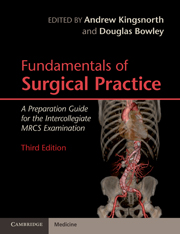Book contents
- Frontmatter
- Contents
- List of contributors
- Preface
- Section 1 Basic Sciences Relevant to Surgical Practice
- Section 2 Basic Surgical Skills
- Section 3 The Assessment and Management of the Surgical Patient
- Section 4 Perioperative Care of the Surgical Patient
- 11 Fundamentals of intestinal failure and nutrition
- 12 Enhanced recovery after surgery
- 13 Fundamentals of intensive care
- 14 Caring for surgical patients: complications and communication
- 15 Management of sepsis
- Section 5 Common Surgical Conditions
- Index
- References
15 - Management of sepsis
Published online by Cambridge University Press: 03 May 2011
- Frontmatter
- Contents
- List of contributors
- Preface
- Section 1 Basic Sciences Relevant to Surgical Practice
- Section 2 Basic Surgical Skills
- Section 3 The Assessment and Management of the Surgical Patient
- Section 4 Perioperative Care of the Surgical Patient
- 11 Fundamentals of intestinal failure and nutrition
- 12 Enhanced recovery after surgery
- 13 Fundamentals of intensive care
- 14 Caring for surgical patients: complications and communication
- 15 Management of sepsis
- Section 5 Common Surgical Conditions
- Index
- References
Summary
Introduction
Severe sepsis and septic shock are common and account for 3% of hospital admissions and 10% of admissions to critical care units. In critically ill patients, sepsis remains the most common cause of mortality. Mortality rates approaching 40% are seen in patients with severe sepsis and up to 80% for patients with septic shock and multi-organ dysfunction syndrome (MODS). It is estimated that approximately 1400 people worldwide die of sepsis every day and 37,000 die of sepsis every year in the UK. There is evidence to suggest that the incidence of severe sepsis is increasing, with a prediction that the number of severe sepsis cases is set to grow at a rate of 1.5% per annum, adding an additional 1 million cases per year in the USA alone by 2020. Sepsis is thought to account for 40% of total ICU expenditure.
Spearheaded by the ESICM (European Society of Intensive Care Medicine), ISF (International Sepsis Forum) and SCCM (Society of Critical Care Medicine), the Surviving Sepsis Campaign® is aimed at improving the diagnosis, survival and management of patients with sepsis by addressing the challenges associated with it.
The Surviving Sepsis® programme aims to:
increase awareness, understanding, and knowledge
change perceptions and behaviour
increase the pace of change in patterns of care
influence public policy
define standards of care in severe sepsis
reduce the mortality associated with sepsis by 25% over the next 5 years
working with the relevant stakeholders, the Surviving Sepsis Campaign's® mission is to improve the management of sepsis through targeted initiatives.
- Type
- Chapter
- Information
- Fundamentals of Surgical PracticeA Preparation Guide for the Intercollegiate MRCS Examination, pp. 248 - 252Publisher: Cambridge University PressPrint publication year: 2011

